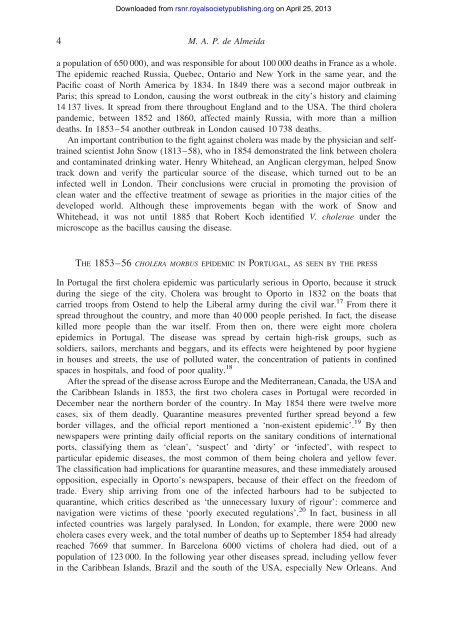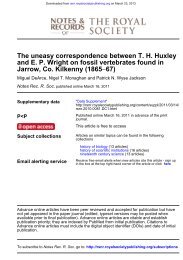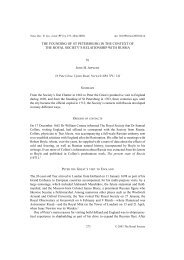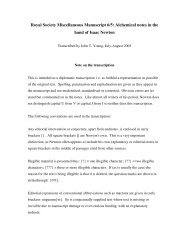THE PORTUGUESE CHOLERA MORBUS EPIDEMIC OF 1853–56 ...
THE PORTUGUESE CHOLERA MORBUS EPIDEMIC OF 1853–56 ...
THE PORTUGUESE CHOLERA MORBUS EPIDEMIC OF 1853–56 ...
Create successful ePaper yourself
Turn your PDF publications into a flip-book with our unique Google optimized e-Paper software.
4<br />
Downloaded from<br />
rsnr.royalsocietypublishing.org on April 25, 2013<br />
M. A. P. de Almeida<br />
a population of 650 000), and was responsible for about 100 000 deaths in France as a whole.<br />
The epidemic reached Russia, Quebec, Ontario and New York in the same year, and the<br />
Pacific coast of North America by 1834. In 1849 there was a second major outbreak in<br />
Paris; this spread to London, causing the worst outbreak in the city’s history and claiming<br />
14 137 lives. It spread from there throughout England and to the USA. The third cholera<br />
pandemic, between 1852 and 1860, affected mainly Russia, with more than a million<br />
deaths. In 1853–54 another outbreak in London caused 10 738 deaths.<br />
An important contribution to the fight against cholera was made by the physician and selftrained<br />
scientist John Snow (1813–58), who in 1854 demonstrated the link between cholera<br />
and contaminated drinking water. Henry Whitehead, an Anglican clergyman, helped Snow<br />
track down and verify the particular source of the disease, which turned out to be an<br />
infected well in London. Their conclusions were crucial in promoting the provision of<br />
clean water and the effective treatment of sewage as priorities in the major cities of the<br />
developed world. Although these improvements began with the work of Snow and<br />
Whitehead, it was not until 1885 that Robert Koch identified V. cholerae under the<br />
microscope as the bacillus causing the disease.<br />
<strong>THE</strong> <strong>1853–56</strong> <strong>CHOLERA</strong> <strong>MORBUS</strong> <strong>EPIDEMIC</strong> IN PORTUGAL, AS SEEN BY <strong>THE</strong> PRESS<br />
In Portugal the first cholera epidemic was particularly serious in Oporto, because it struck<br />
during the siege of the city. Cholera was brought to Oporto in 1832 on the boats that<br />
carried troops from Ostend to help the Liberal army during the civil war. 17 From there it<br />
spread throughout the country, and more than 40 000 people perished. In fact, the disease<br />
killed more people than the war itself. From then on, there were eight more cholera<br />
epidemics in Portugal. The disease was spread by certain high-risk groups, such as<br />
soldiers, sailors, merchants and beggars, and its effects were heightened by poor hygiene<br />
in houses and streets, the use of polluted water, the concentration of patients in confined<br />
spaces in hospitals, and food of poor quality. 18<br />
After the spread of the disease across Europe and the Mediterranean, Canada, the USA and<br />
the Caribbean Islands in 1853, the first two cholera cases in Portugal were recorded in<br />
December near the northern border of the country. In May 1854 there were twelve more<br />
cases, six of them deadly. Quarantine measures prevented further spread beyond a few<br />
border villages, and the official report mentioned a ‘non-existent epidemic’. 19 By then<br />
newspapers were printing daily official reports on the sanitary conditions of international<br />
ports, classifying them as ‘clean’, ‘suspect’ and ‘dirty’ or ‘infected’, with respect to<br />
particular epidemic diseases, the most common of them being cholera and yellow fever.<br />
The classification had implications for quarantine measures, and these immediately aroused<br />
opposition, especially in Oporto’s newspapers, because of their effect on the freedom of<br />
trade. Every ship arriving from one of the infected harbours had to be subjected to<br />
quarantine, which critics described as ‘the unnecessary luxury of rigour’: commerce and<br />
navigation were victims of these ‘poorly executed regulations’. 20 In fact, business in all<br />
infected countries was largely paralysed. In London, for example, there were 2000 new<br />
cholera cases every week, and the total number of deaths up to September 1854 had already<br />
reached 7669 that summer. In Barcelona 6000 victims of cholera had died, out of a<br />
population of 123 000. In the following year other diseases spread, including yellow fever<br />
in the Caribbean Islands, Brazil and the south of the USA, especially New Orleans. And










